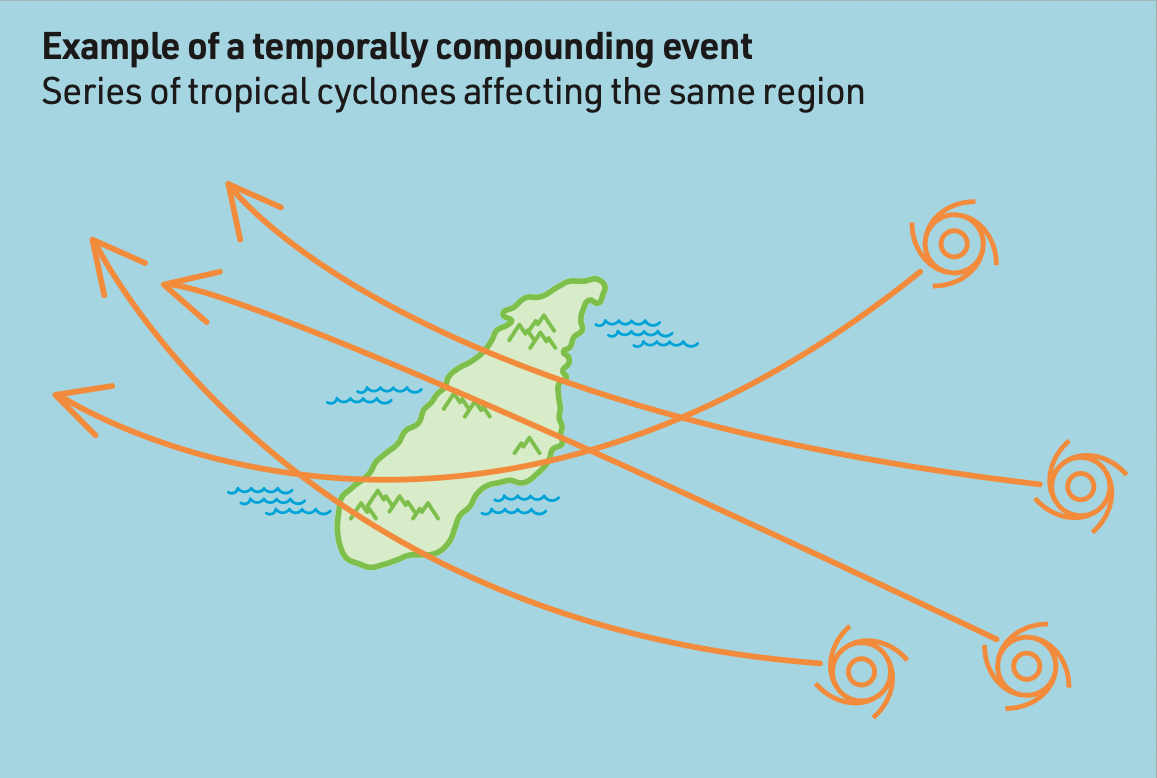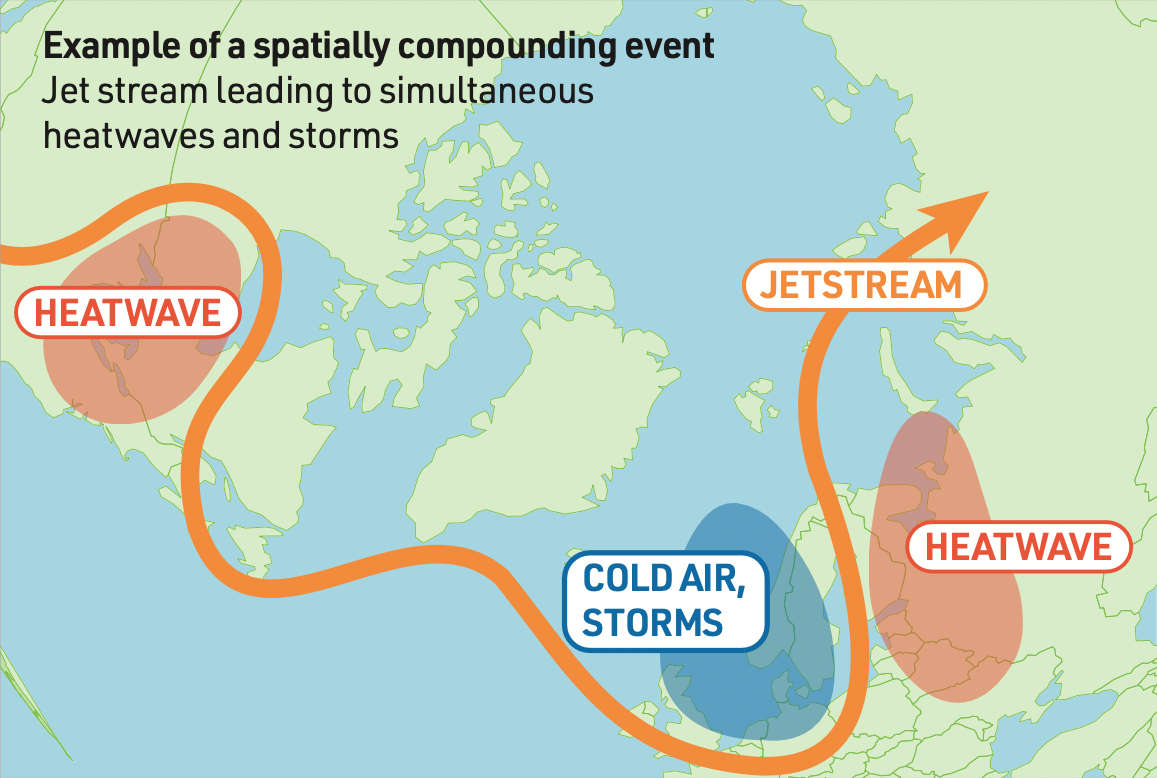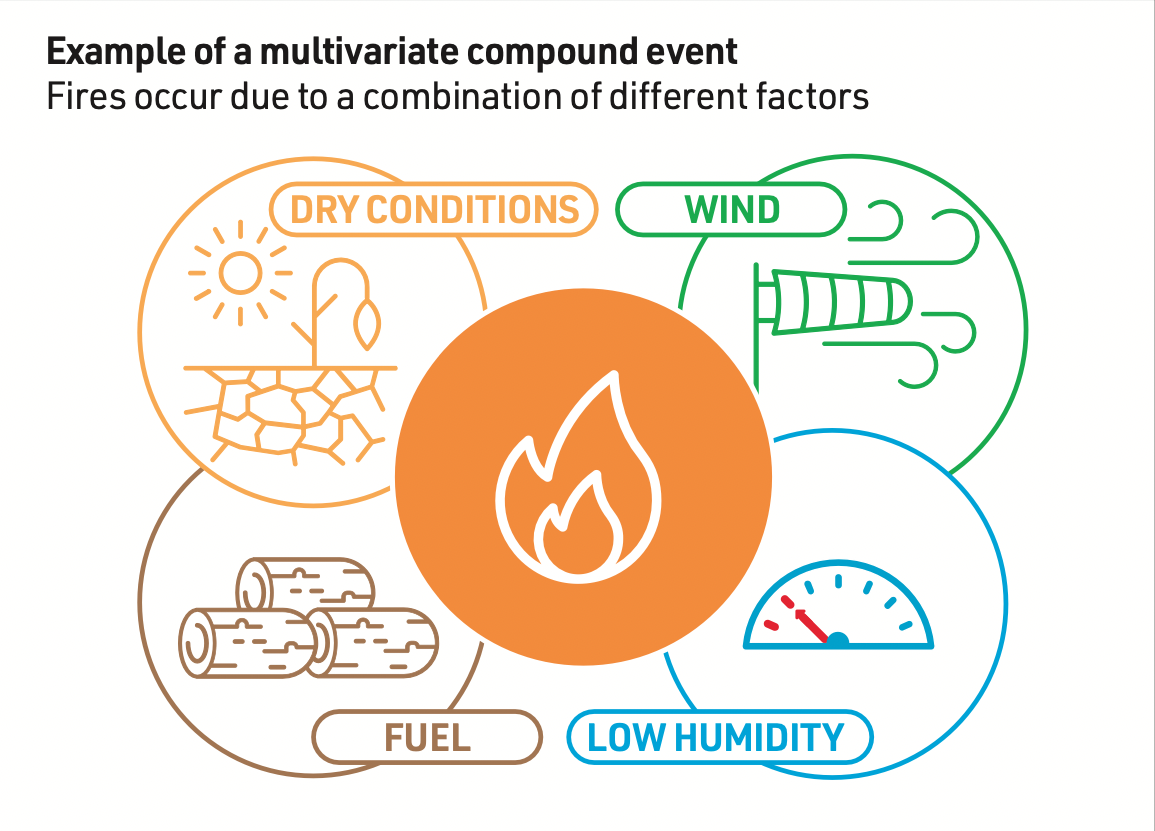- Compound events are combinations of weather and climate hazards that have the potential to cause more severe socio-economic impacts than hazards occurring in isolation
- Australia has experienced a variety of compound events that have led to loss of life and negatively impacted the Australian economy over the past decades
- The ARC Centre of Excellence for Climate Extremes is leading research that will ultimately help businesses and governments better assess the risks posed by compound events
What are compound events?
Natural disasters are often caused by a combination of multiple weather and climate hazards. The cumulative effect of these weather and climate hazards makes these events particularly devastating, causing severe impacts for communities, economies, and ecosystems. In climate science, these events are referred to as “compound events”1, or CEs. CEs can put significant stress onto any socio-economic or ecological system, including those linked to food production and security, supply chain functionality, and insurance with their impacts reaching down to the individual level with property damage/loss, sickness, and even loss of life.
Unfortunately, our scientific understanding of CEs is far from complete and this limits our ability to assess and prepare for the risks that they pose. Some of these risks have been highlighted by the recent extensive flooding in Queensland and New South Wales (see below). The need for further research on CEs has been recognised by business2, state and national governments3,4, and international bodies, such as the UN’s Intergovernmental Panel on Climate Change5.

An example compound event: Flooding in Queensland and
New South Wales, February and March 2022
The extensive flooding affecting Queensland and New South Wales in late summer and early autumn of 2022 shows many characteristics of a compound event. Many processes contributed to the immense impact of this event. Like during the previous flooding in New South Wales in March 2021, extreme rainfall fell on river catchments that were still saturated from earlier particularly wet seasons. Further, in the case of New South Wales, the event in 2022 was started by extreme rainfall from a low-pressure trough lingering off Australia’s east coast but the largest part of the flooding was then caused by additional rainfall brought by an East Coast Low. Both systems also caused onshore winds that resulted in elevated sea levels along parts of the coastline. This hindered the drainage of the flood waters into the ocean, exacerbating the impact of the rainfall. The fact that multiple regions (e.g. Brisbane, southern Queensland, northern New South Wales, Sydney) were affected at the same time also has characteristics typical of a compound event.
CEs are difficult to define and classify due to their complexity, despite a lot of research devoted to this1,5,6. However, in broad terms, CEs come in four specific types, with the proviso that a CE might not always fit neatly into one of these categories7. Indeed, the recent Queensland and New South Wales flooding shows characteristics typical of all four categories.
Different types of compound event




Pre-conditioned events
A preconditioned event occurs when the impact of a hazard is exacerbated by pre-existing conditions. For example, in March 2021, large parts of New South Wales experienced extensive rainfall that led to widespread flooding8. The impact of the rainfall (the extent and severity of the flooding) was exacerbated by the preconditioning of river catchments. The catchments had received above average rainfall caused by La Niña conditions during the previous summer, filling water reservoirs and saturating soils. As such the additional water could not be absorbed by the system and this resulted in significant flooding.
Temporally Compounding Events
A temporally compounding event occurs when a series of hazards affects the same region, exacerbating the impact of any of the individual events. For example, the impact of a series of tropical cyclones in quick succession could impact a region far more than if there was more time between the cyclones. An Australian example is when, in June 2007, coastal New South Wales was hit by five East Coast Lows in close succession, causing flooding and damage. The impact of each individual storm was exacerbated where the different storms affected regions that were still in the process of recovering from the previous storm and put stress on emergency services, which had little time to recover between events.
Spatially Compounding Events
A spatially compounding event occurs when several impacts occur at the same time but at different locations. An example is the high-impact weather events in the Northern Hemisphere in June and July 2021, which included an extreme heatwave in North America and heavy rainfall leading to flooding in Europe and China. These events were caused by a common atmospheric mechanism: undulations in the jet stream, a band of strong winds in the upper atmosphere9. Another example is the Australian Black Summer of 2020/21, when numerous bushfires occurred in many different regions within the same emergency services jurisdiction. This led to nationwide losses exceeding A$10 billion10.
Multivariate Compound Events
A multivariate event occurs when several hazards affect the same region at the same time. Each of the fires occurring during the Australian Black Summer bushfires qualifies as a multivariate compound event as it was caused by the simultaneous occurrence of several hazards including high temperature, low humidity, dry conditions leading up to the event, and strong winds in the same region. The ARC Centre of Excellence for Climate Extremes has recently published research on the occurrence of multivariate compound events across the globe. This will be the subject of a future briefing note.
Why do we need new research?
Traditional extreme event analysis has focused on one hazard or driver being extreme at a time. To a large degree this was a necessary step in understanding the causes of the hazard or driver. However, this focus neglected two very important principles.
First, high impact weather and climate events do not always result from extreme conditions if a combination of hazards are involved. For instance, tropical cyclones and other storms often cause significant damage due to wind driven rain that occurs at wind speeds below the maximum wind speeds of the system11.
Second, the interaction of different hazards causing CEs makes their occurrence much more (or, in some instances, less) likely than a single hazard. For instance, low-pressure systems that bring strong winds often also cause heavy rainfall in the same region. This means that knowing a region is experiencing strong winds associated with a front may increase the likelihood of heavy rainfall in the same region.
Fortunately, there is a now growing literature on all types of CEs. Traditionally, multivariate events receive significant interest12,13,14,15,16 with a special focus often evolving around coastal flood risk due to the co-occurrence of heavy rainfall, high river discharge, waves, or storm surge. However, cyclone clusters, temporally compounding events, have also been studied in great detail in the past17,18,19.
Despite considerable international efforts, our understanding of many CEs is insufficient to reliably assess the risk they pose. Although we have identified interactions between many hazards, there are still many possible hazard combinations that can have an impact, but that we haven’t encountered yet. In addition, there could be hazard combinations that could lead to severe impacts that we are just not aware of.
Another reason is that CEs often occur less frequently than single hazard extreme events. Current observational records are not sufficiently long and/or are too sparse to perform reliable statistical analyses. This means that we cannot be certain how well our climate models reproduce the interactions that are at the base of CEs in many (but not all) circumstances.
For these reasons, the ARC Centre of Excellence for Climate Extremes has incorporated CEs into its program of research. The CE expertise of its researchers is being recognised internationally by both the scientific and business communities. The Centre’s research on CEs will be the subject of several future briefing notes.
Briefing note created by Dr Nina Ridder, Professor Andy Pitman, Dr Ian Macadam and Allyson Crimp.
